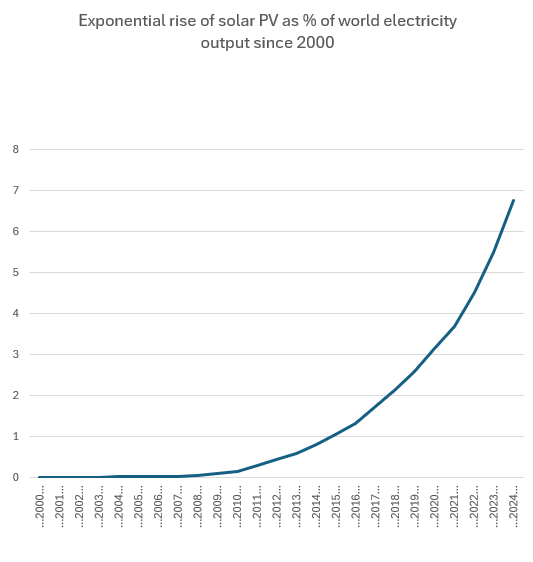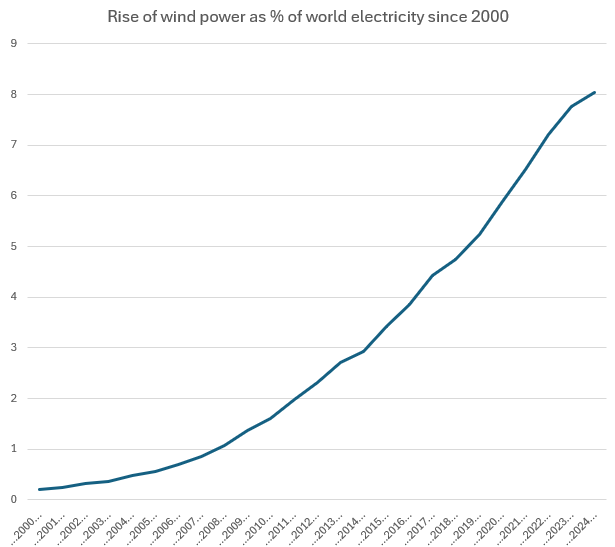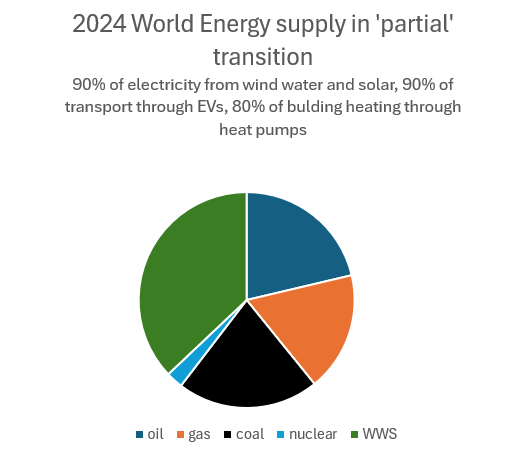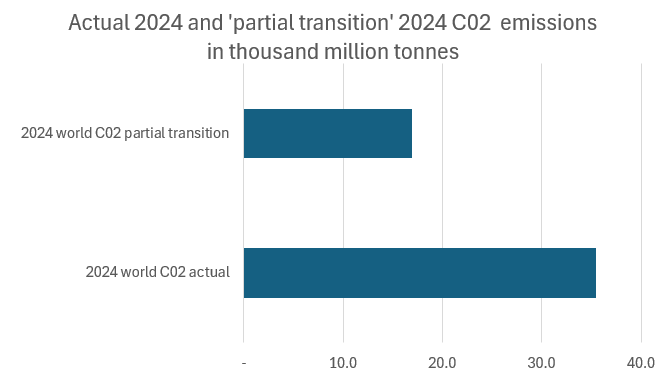How small increases in renewables produce big cuts in carbon emissions
Wind and especially solar PV production is accelerating and the renewable energy era is just starting to replace the fossil fuel era
The global energy debate today is weighed down by fossil fuel supporters who support their case by pointing out the alleged ‘small’ share of renewables in the world energy economy, as measured by ‘primary energy’. In fact the energy statistics are built to suit the fossil fuel and nuclear industries, not renewable energy and energy efficiency technologies. In this post I show how even small increases in the share of renewables produce much larger proportional reductions in carbon emissions.
A model of how renewables eat fossil fuels
In the model I use below, renewable energy increases by just under a quarter of current world energy consumption, but carbon emissions are reduced by over half. As this happens the total amount of energy needed to sustain the world economy contracts as the waste is eliminated.
The so-called small share of renewable energy compared to so-called ‘prmary energy’ is not only growing fast, as can be seen n Figures 2 and 3. Also this renewable energy eats fossil fuels at an increasing rate. It does this by two essential means. First, using renewable sources like solar and wind involves no wasted energy in their production. In the case of fossil fuels and nuclear power something between 50 and 80 per cent of their energy is wasted in their production of electricity. The majority of energy goes up cooling towers. Even higher proportions of fossil fuel power are wasted in providing services like heating and motive power for vehicles. The second means by which renewable energy ‘eats’ fossil fuel consumption is because electrified technologies which are used by water, wind and solar (WWS) are three times more efficient users of energy. I use the examples of electric vehicles (EVs) and heat pumps in the model below.
The result is that when renewable energy replaces fossil fuels then the amount of energy consumed falls to a small fraction of what is reflected in so-called ‘primary energy’ statistics. The dominant way of counting energy use is so-called ‘primary energy’, which simply counts the number of energy units sold across the world. But this gives us a distorted view of the energy world. As Professor Jan Rosenow says: ‘The primary energy fallacy is the idea that all primary energy from fossil fuels must be replaced with an equivalent amount of clean energy.’ (see HERE) Primary energy counts the (majority of) energy that is wasted, whilst renewable-electric systems are much less wasteful.
A more useful concept is, yes, the concept of ‘useful’ energy. Hannah Ritchie defines it thus: ‘It is the energy that goes towards the desired output of the end-use application. For a lightbulb, it’s the amount of light that is produced. For a car, it’s the amount of kinetic (movement) energy that is produced.’ (see HERE)
In the fossil fuel era energy technologies were invented and then energy suppliers sought to supply that market. Most of the energy is wasted before it is turned into useful energy. In the renewable energy era, just starting, the most practical energy efficient solutions are given priority to be supplied, almost always by renewable electricity sources. Electrically based solutions, such as heat pumps for heating and electric vehicles in transport, are invariably the most efficient ways of using energy. They are three times more efficient than their fossil fuel equivalents, the internal combustion engine and gas/diesel boilers respectively. These gains in efficiency are on top of the reductions in wastage in making electricity compared to fossil fuels or nuclear power (mentioned earlier).
Essentially decabonisation relies on two things. First, renewables becoming an increasing proportion of electricity supply, and second, electricity becoming a larger and larger proportion of total energy.
In the first case, the Figure 1 shows how renewables are becoming a larger and larger share of world electricity supply. Indeed almost all of new electricity generating capacity is now renewable. See my earlier post HERE.
Figure 1
Source: 2025 Energy Institute Statistical Review of World Energy (EISRWR)
In Figures 2 and 3 we can see the rapid increase in generation of solar power and wind power.
Figure 2
Figure 3
Regarding the second trend, towards electricity becoming a larger and larger provider of useful energy, there are a range of energy technologies that are leading towards electrification. For an analysis of this trend, see HERE.
Below in Figure 3 I produce a ‘primary energy’ analysis of world energy supply. Both renewable energy and nuclear energy are visualised here simply for the amount of energy that is generated as electricity. Indeed some agencies even include the nuclear energy that is wasted in cooling towers, which articifically multiplies the energy produced by nuclear power 2-3 times. The counting method I use does not do this, but it still includes all of the energy wasted by fossil fuel technologies. I do this to show how the dynamic effect of increasing renewables reduces carbon emissions (see Figures 4 and 5).
Figure 3
This Figure 3 compares with Figure 4 where, I model most of electricity, transportation and and the bulk of space heating being provided by renewable electricity (WWS). I call this a ‘partial transition’. Of course in time there will be full transition, but I use the concept of ‘partial transition’ to show how even this produces radical reductions in carbon emissions.
In Figure 4 total energy needed to provide exactly the same energy services as were provided in 2024 (see Figure 3) is reduced by 16 per cent. This reduction, combined with the substitution of fossil fuels by renewable energy produces a reduction of carbon emissions of 52 per cent compared to what actually happened in 2024. This reduction in carbon emissions is shown in Figure 5.
Figure 4
As can be seen in Figure 5 the reduction in carbon emissions from this partial trasnsition is over 52 per cent.
Figure 5
It should be emphasised that the model I use here deals only with a rather more limited process of electrification than will occur. I deal only with electrification of transport and space heating, and not all of these. I assume that 90 per cent of transport is electified, alongside 80 cent of space heating. I assume that 90 per cent of electricity is provided by renewables (WWS), the rest of electricity coming from nuclear power and some residual fossil fuels.
Future trends
Passenger vehicles and light goods vehicles are turning towards EVs. Heavy goods vehicles will be next. Even battery-powered electric aircraft are on the horizon. Batteries tested in the laboratory already have sufficiently high energy density to power large aircraft around Europe.
There are also significant shifts towards electrification of space heating. For example, in European countries such as the UK, France and Germany heat pumps are effectively mandatory in new buildings, and incentives and regulations are promoting heat pumps heavily in China. All of these changes would not happen without the spur of the realisation of how protecting the climate also aids energy security.
These trends will intensify throughout the world in the coming years. Politicians like Donald Trump may slow progress for a small period, but after them others will come along. They will give a push to the markets to advance the green energy revolution. It is unstoppable. This new realisation and policy trajectory represents a much more proactve and institutionally-led drive towards energy efficiency. This is as opposed to the case before climate politics became important where efficiency gains happened mostly because of market pressures.
Of course it can be argued that by the time all these changes take effect world energy demand will have moved on. World energy production increased in the years 2014-24 by an average of 1.3 per cent per year (according to the EISRWR) . However, electricity makes up a lot of this increase at around 2.6 per cent per annum. 2024 saw a much more rapid increase at 4 per cent largely because of the very big rise in use of air conditioning in what was a very hot summer in many parts of the world. The IEA reported that: ‘As a result of higher power consumption, natural gas saw the strongest increase in demand among fossil fuels in 2024. Gas demand rose by 115 billion cubic metres (bcm), or 2.7%, compared with an average of around 75 bcm annually over the past decade.’ (see HERE)
But why should gas use for electricity (or for that matter anything else) be increasing? It is mainly because of the gas burning technology that is already in place. The gas generation is increasingly being replaced by renewables, which now constitute most of new generation. We need to make sure it is replaced as soon as possible. Most of it will, indeed, be replaced with the current rate of deploying renewable energy in the electricity sector. We must make sure that the self-described ‘net zero sceptics’ do not slow this trend.
The point here is that in future, with renewable energy making up almost all of the new generation being installed, the increase in world energy consumption will mostly be renewable anyway. However, not only will renewable energy be ‘eating’ the increases in energy demand it will also be replacing much of the existing fossil fuel conumption with less, but more efficient, renewable energy. New areas of electrification (which produce new markets for renewables) will also open up, besides the ones already mentioned, which will also ‘eat’ fossil fuel energy demand. Added to this battery and other storage technologies are becoming cheaper and ever more common. These help integrate renewables and propel forward vartious aspects of green technology
Conclusion - Pressing the energy revolution forward
I cannot say exactly how far into the future this type of model will be realised in practice. However the ‘revolution’ is already under way. It is inevitable, but it will be speeded or slowed (respectively) by the politics of climate advocacy and fossil fuel resistance. What is certain, however, is that leaving things to the market and the big corporations to follow targets set by Government is far from enough. We need a big increase in grass roots climate actions to make sure the policies are in place to speed the transition. This climate action involves people at the grass roots organising green energy initiatves.








David, what you have written is fine as far as it goes, but seems to under-estimate the significance of the fact that, in attempting to substitute for all fossil fuel use, renewable energy is chasing a retreating target. From 2000 to 2019, global renewable energy (RE) generation grew at a very high rate. But, in 2019, fossil fuels still supplied 80% of global total final energy consumption (TFEC), THE SAME AS IN YEAR 2000. (By 2022-23, this had dropped to 78%.) This fundamental problem is not the fault of RE, which has grown beyond expectations in percentage terms, but is the result of growing TFEC. While RE has a higher growth RATE than TFEC, RE's absolute growth in EJ is still much less than TFEC's. Most of growth in TFEC is still fossil fuelled. While RE will overtake fossil energy EVENTUALLY, it cannot do this by 2050 while TFEC continues to grow. See my article: https://cleantechnica.com/2024/08/20/the-energy-transition-is-slowed-by-growth-in-consumption/
For sure wind & solar can deliver most new energy demand and continue to displace significant amounts of coal and gas but until long duration storage is sorted your not going to totally eliminate fossil fuels.